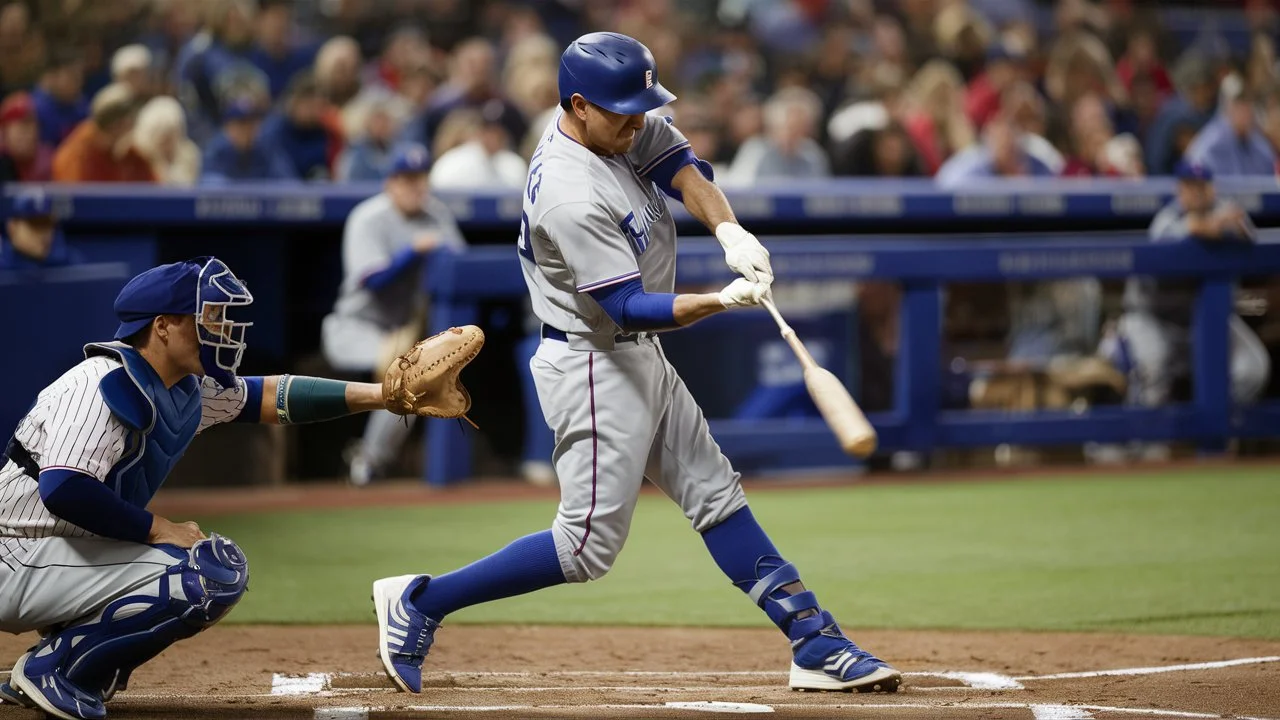Last updated on October 1st, 2024 at 05:12 pm
Baseball is one of the most beloved sports in America, capturing the hearts of millions. Understanding how many players are on a baseball team is key to appreciating the game.
This article will explain the number of players on a baseball team, their roles, and how team composition varies.
- Basic Team Composition: We’ll look at the standard team size and the differences between various leagues.
- Positions and Roles: Each player’s role, from pitchers to outfielders, will be covered.
- Special Situations and Variations: Learn about expanded rosters, the injured list, and two-way players.
- Minor League and Amateur Teams: Explore how team composition differs in minor leagues, college baseball, and youth leagues.
- Historical and International Perspectives: Discover how team sizes have changed over time and how they differ internationally.
By the end, you’ll understand the dynamic nature of baseball team rosters and the importance of each player’s role.
Whether you’re a fan, coach, or player, this guide will help you appreciate the strategic aspects of baseball.
Let’s dive in and explore the fascinating world of baseball team composition!
Basic Team Composition

Total Number of Players
A professional baseball team typically consists of 5 to 6 players during the regular season. This number ensures that the team has enough players to cover all positions and provide backups.
However, this can vary slightly depending on the league.
- Major League Baseball (MLB): The MLB standard roster size is 6 players during the regular season.
- Minor Leagues: Minor league teams often have smaller rosters, typically around 4 players.
- International Leagues: The number of players can vary. For instance, Japanese and Korean leagues may have different roster sizes.
Active Roster vs. Full Roster
The active roster refers to the players available for a game, while the full roster includes all players under contract, including those on the injured list or in the minor leagues.
- Active Roster: Usually consists of 6 players in the MLB. These are the players eligible to play in games.
- Full Roster: Can include up to 4 players. This roster includes players who can be called up from the minor leagues, those on the injured list, and others who are not currently active.
The difference between the active and full roster is crucial for team strategy and management.
Coaches need to decide which players to activate for each game, balancing the needs of the team with player availability and health.
Understanding these basic aspects of team composition helps fans and aspiring players appreciate the complexity of managing a baseball team.
It’s not just about having enough players but having the right mix to cover every position and scenario.
This foundation sets the stage for a deeper exploration of the roles and responsibilities of each player on the team.
Positions and Roles

Pitchers
Pitchers are vital to a baseball team. They are responsible for throwing the ball to the batter, aiming to get them out. There are different types of pitchers, each with a unique role:
- Starting Pitchers: They begin the game and usually pitch for several innings. A team typically has 5 starting pitchers in their rotation.
- Relief Pitchers: These pitchers come in after the starting pitcher and pitch for a shorter duration. They include:
- Middle Relievers: Enter the game in the middle innings.
- Setup Men: Pitch in the late innings, setting up for the closer.
- Closer: The pitcher who finishes the game, usually in the last inning, aiming to secure the win.
Pitchers are essential to controlling the game, and teams often have a well-structured bullpen to handle various situations.
Catchers
Catchers are key players who squat behind the batter and catch pitches. Their main responsibilities include:
- Receiving Pitches: Catching the ball thrown by the pitcher.
- Fielding Bunts and Pop Flies: Quickly fielding and throwing to get outs.
- Signaling: Communicating with the pitcher about the type of pitch to throw.
Teams usually have a primary catcher and a backup catcher to ensure this critical position is always covered.
Infielders
Infielders play close to the bases and are involved in many defensive plays. The infield positions include:
- First Baseman: Catches throws from other infielders to get runners out at first base.
- Second Baseman: Covers second base and often collaborates with the shortstop on double plays.
- Shortstop: Positioned between second and third base, responsible for fielding ground balls and making quick throws.
- Third Baseman: Covers third base, often fielding hard-hit balls down the line.
Infielders must be quick, agile, and have strong throwing arms to make plays and get outs.
Outfielders
Outfielders cover the large area beyond the infield. They must be fast and have good catching and throwing skills. The outfield positions include:
- Left Fielder: Covers the area in left field, backing up infielders and catching fly balls.
- Center Fielder: Often the fastest outfielder, covering the most ground and catching deep fly balls.
- Right Fielder: Covers right field and often has a strong arm to throw to bases.
Outfielders are crucial for preventing hits from turning into extra bases and making key defensive plays.
Designated Hitter (DH)
The Designated Hitter is a unique position primarily used in the American League. The DH bats in place of the pitcher, allowing pitchers to focus on their pitching duties without having to bat.
This role can significantly impact a team’s offensive strategy, providing more power in the batting lineup.
Understanding these positions and roles is essential for appreciating the strategic depth of baseball.
Each player has specific responsibilities that contribute to the team’s overall success. Whether it’s pitching, catching, or fielding, every role is vital in the complex and exciting world of baseball.
Special Situations and Variations

. Expanded Rosters
In certain situations, teams can expand their rosters. This usually happens towards the end of the season.
- September Call-Ups: In September, MLB teams can expand their rosters from 6 to players.
- This allows teams to bring up players from the minor leagues, giving them more options for games and a chance to rest regular players. It’s a crucial time for evaluating future talent and preparing for the postseason.
- Impact on Team Composition: Expanded rosters provide teams with greater flexibility. They can test new strategies, give playing time to emerging players, and manage player fatigue. It also helps teams deal with injuries more effectively.
Injured List (IL)
Players sometimes get injured and need time to recover. The injured list (IL) allows teams to manage these situations.
- Injured List Rules: Players placed on the IL cannot play for a set period, usually or 5 days. This rule helps teams replace injured players temporarily without losing a roster spot.
- Replacement Players: Teams can call up players from the minor leagues to fill in for those on the IL. This ensures that the team always has a full active roster.
- Managing the Roster: Using the IL effectively is crucial for team success. It allows teams to keep their best players healthy and ensures they have enough depth to compete.
Two-Way Players
Two-way players can both pitch and play a position, offering unique flexibility to a team.
- Definition: A two-way player is someone who regularly plays both as a pitcher and a position player. This rare skill set can be a significant asset to a team.
- Examples: Famous two-way players include Babe Ruth and more recently, Shohei Ohtani. These players can contribute both offensively and defensively.
- Impact on Team Dynamics: Having a two-way player can save a roster spot, allowing the team to carry an extra pitcher or position player. It also adds strategic depth, as these players can be used in multiple ways.
Understanding these special situations and variations helps fans see the complexity of managing a baseball team.
Expanded rosters, the injured list, and two-way players all add layers of strategy to the game. Teams must navigate these factors to stay competitive and make the most of their talent.
Whether dealing with injuries or taking advantage of unique player skills, successful teams are those that adapt and manage their rosters effectively.
This flexibility and depth are what make baseball such a dynamic and exciting sport.
Minor League and Amateur Teams

Minor League Teams
Minor league baseball is essential for developing future MLB players. The team composition in the minor leagues can differ from the major leagues.
- Roster Size: Minor league teams typically have around 4 to 5 players. This number ensures they have enough players to cover all positions while focusing on player development.
- Development Focus: The primary goal in the minor leagues is to develop players’ skills and prepare them for the major leagues. Coaches in the minors work on improving players’ techniques, understanding of the game, and physical conditioning.
- Team Levels: Minor leagues are divided into several levels, including Triple-A, Double-A, and Single-A. Each level provides a different degree of competition and development focus, with Triple-A being the closest to the majors.
College Baseball Teams
College baseball is another crucial stage for young players. The structure of college teams differs from professional and minor league teams.
- Roster Size: College baseball teams usually have larger rosters, with around 5 players. This includes active players and redshirts (players who practice with the team but do not play in games to preserve a year of eligibility).
- Scholarships: Players in college baseball often receive scholarships that help pay for their education. These scholarships are vital for attracting talented players to college programs.
- Development and Education: College baseball not only develops players’ athletic skills but also emphasizes their education. Balancing academics and athletics is a significant aspect of college sports.
Little League and Youth Baseball
Youth baseball is where many players start their journey. Team sizes and structures can vary significantly at this level.
- Team Size: Little League and other youth baseball teams typically have to 5 players. This smaller size ensures that all players get ample playing time and attention from coaches.
- Flexibility: Youth baseball is more flexible regarding team composition. Teams may adjust their rosters based on the number of available players, focusing more on participation and enjoyment than strict adherence to positions.
- Learning and Fun: The primary goal of youth baseball is to teach kids the basics of the game, sportsmanship, and teamwork. Ensuring the experience is enjoyable encourages lifelong love for the sport.
Understanding the structure and goals of minor league, college, and youth baseball teams provides a comprehensive view of baseball’s development pipeline.
Each level has its unique focus, from the intense development of future stars in the minors to balancing education and athletics in college, and fostering love for the game in youth leagues.
This journey helps young players grow, learn, and aspire to reach the professional level, keeping the sport vibrant and competitive.
Historical and International Perspectives
Historical Changes in Team Composition
The composition of baseball teams has evolved significantly over the years.
- Early Baseball Teams: In the early days of baseball, team sizes were smaller, often with just to players. Substitutions were rare, and players often played multiple positions.
- Growth in Team Sizes: As the sport developed, team sizes increased. By the mid-th century, MLB teams had expanded their rosters to include more specialized roles, such as relief pitchers and designated hitters.
- Modern Era: Today, MLB teams typically carry 6 players during the regular season, reflecting the need for specialized roles and strategic depth. The introduction of the injured list and expanded rosters in September has also influenced team composition.
International Baseball Teams
Baseball is played globally, and team compositions can vary by country and league.
- Japanese Baseball: In Nippon Professional Baseball (NPB), teams usually have players on their active roster, with a mix of domestic and international players. The focus is on teamwork and fundamental skills.
- Korean Baseball: The Korea Baseball Organization (KBO) also features a roster size similar to the MLB, typically with 6 to players. The league is known for its passionate fans and high-scoring games.
- Latin American Leagues: Countries like the Dominican Republic, Venezuela, and Mexico have vibrant baseball cultures. Team rosters in these leagues are similar to MLB, but they often emphasize developing young talent for eventual transition to the major leagues.
Understanding historical and international perspectives provides a deeper appreciation for the diversity and evolution of baseball. The sport has grown and adapted in different regions, reflecting local cultures and traditions while maintaining the core elements that make baseball exciting.
By exploring these changes and differences, fans can gain a broader view of how baseball teams are composed and how the game is played worldwide.
Conclusion
Baseball’s complexity and strategic depth are reflected in its team composition. From the basic roster sizes in major leagues to the specialized roles of pitchers and catchers, every player has a crucial part to play.
Special situations like expanded rosters, the injured list, and the emergence of two-way players add layers of strategy to team management.
In the minor leagues, college baseball, and youth leagues, the focus shifts to development and education, ensuring a continuous supply of talent for the sport.
Historical changes and international perspectives further highlight baseball’s dynamic nature and its adaptation to different cultures and eras.
Whether you’re a fan, coach, or player, understanding the number of players on a baseball team and their roles enhances your appreciation of the game.
It shows how each player’s contribution is vital to the team’s success and how baseball remains a beloved sport with a rich history and global appeal. Keep exploring, learning, and enjoying the wonderful world of baseball!
The Importance of Each Role in a Baseball Team
Pitchers’ Importance
Pitchers are central to a team’s defense. They set the tone for the game and can control the pace of play.
- Starting Pitchers: They often pitch the first five to seven innings. Their performance can set the momentum for the rest of the game. A strong starting pitcher can dominate the opposing team, limiting their scoring opportunities.
- Relief Pitchers: They come in to maintain or change the game’s momentum. Their job is to handle high-pressure situations, whether it’s stopping a scoring rally or preserving a lead.
- Closer: They finish the game, usually in the ninth inning, to secure the win. Their ability to handle pressure is crucial for the team’s success in tight games.
Catchers’ Importance
Catchers are the defensive leaders on the field. They work closely with pitchers and manage the defense.
- Game Management: Catchers call pitches and strategize with the pitchers. They study opposing batters and know their tendencies, which helps in making smart pitch choices.
- Defensive Skills: Catchers need quick reflexes and strong throwing arms to catch runners stealing bases. Their defensive skills can prevent the opposing team from gaining extra bases and scoring.
- Leadership: They guide the defense and keep everyone on the same page. Catchers often act as on-field coaches, providing direction and motivation to their teammates.
Infielders’ Importance
Infielders are involved in many plays and must be quick and accurate.
- First Baseman: They need to catch throws from other infielders to get outs at first base. They often field hard-hit ground balls and make quick decisions.
- Second Baseman and Shortstop: They are key to turning double plays. Their coordination and quick throws are essential for getting two outs in one play.
- Third Baseman: They handle sharp grounders and bunts down the third base line. Their quick reactions and strong arms are crucial for making long throws to first base.
Outfielders’ Importance
Outfielders cover a lot of ground and prevent extra-base hits.
- Left Fielder: They back up infielders and catch fly balls. Their accurate throws can stop runners from advancing to extra bases.
- Center Fielder: Often the fastest outfielder, they cover the most ground. They catch deep fly balls and lead the outfield defense.
- Right Fielder: They need a strong arm to throw out runners at third base or home plate. Their role is crucial for preventing extra-base hits and making key defensive plays.
Designated Hitter (DH) Importance
The DH adds an extra layer of offense to the team, particularly in the American League.
- Offensive Power: The DH can focus solely on batting, often leading to better offensive performance. They can provide crucial hits and home runs to boost the team’s score.
- Strategic Flexibility: The DH allows teams to rest their pitchers from batting duties, keeping them focused on pitching. This role can be used to keep the batting lineup strong, even if the pitcher isn’t a good hitter.
Understanding the importance of each role on a baseball team highlights how each player’s contribution is vital to the team’s success.
Whether it’s pitching, catching, fielding, or hitting, every position requires unique skills and responsibilities.
This detailed look at player roles and their significance adds depth to our understanding of the game, showing how teamwork and individual performances come together to create the excitement and strategy of baseball.
The Role of Coaches and Support Staff
Head Coach (Manager)
The head coach, often called the manager, is the team’s leader. They make key decisions and strategize to help the team win.
- Game Strategy: The manager decides the batting order, pitching rotation, and in-game tactics. Their decisions can influence the outcome of the game.
- Player Management: The manager handles player substitutions and manages the bullpen. They ensure that players are well-rested and ready to perform.
- Motivation and Leadership: The manager motivates the team, providing guidance and support. They help maintain team morale and focus throughout the season.
Pitching Coach
The pitching coach specializes in helping pitchers improve their skills and performance.
- Training and Development: They work with pitchers on techniques and mechanics. Their guidance helps pitchers develop better control and effectiveness.
- Game Preparation: The pitching coach analyzes opposing batters and helps pitchers prepare for games. They devise strategies to exploit weaknesses in the opposing team’s lineup.
- In-Game Adjustments: During games, the pitching coach advises on pitch selection and adjustments. They monitor pitchers’ performance and provide real-time feedback.
Hitting Coach
The hitting coach focuses on improving the team’s offensive performance.
- Batting Techniques: They help players refine their batting stance, swing mechanics, and timing. Good coaching can lead to more consistent hitting and better offensive output.
- Scouting Reports: The hitting coach studies opposing pitchers and provides insights to batters. They help players understand what pitches to expect and how to handle them.
- Mental Preparation: Hitting is as much mental as it is physical. The coach helps players maintain focus and confidence, especially during slumps.
Bench Coach
The bench coach assists the manager and acts as a key advisor.
- Game Management: They help with in-game strategy and decision-making. This includes advising on player substitutions, defensive alignments, and tactical plays.
- Player Support: The bench coach provides additional support to players, offering advice and encouragement. They help maintain a positive team environment.
- Succession Planning: The bench coach is often seen as a potential future manager. They learn and prepare to step into the manager role if needed.
Base Coaches
Base coaches are positioned at first and third base during games. They play crucial roles in guiding runners and coordinating offensive plays.
- First Base Coach: They assist base runners with reading the defense and making decisions. They help runners with timing steals and advancing on hits.
- Third Base Coach: They direct runners around third base and towards home plate. Their signals and instructions can influence the outcome of scoring plays.
Training and Medical Staff
The training and medical staff ensure players stay healthy and in peak condition.
- Athletic Trainers: They work on injury prevention and recovery. Their role includes treating injuries, leading rehabilitation programs, and ensuring players are fit to play.
- Team Doctors: They handle medical issues and provide expert care. Their involvement is crucial for managing serious injuries and overall player health.
- Strength and Conditioning Coaches: These coaches focus on players’ physical fitness. They design and implement workout programs to enhance strength, agility, and endurance.
Scouts and Analysts
Scouts and analysts provide critical information that helps the team make informed decisions.
- Scouting: Scouts evaluate talent at all levels, from high school prospects to professional players. Their reports help teams draft new players and make trades.
- Data Analysts: They analyze game data to identify trends and improve performance. Advanced analytics can provide insights into player strengths and weaknesses, influencing strategic decisions.
Understanding the roles of coaches and support staff underscores the collaborative effort required to run a successful baseball team.
Each coach and staff member brings specialized skills and knowledge, contributing to player development, game strategy, and overall team success.
Their combined efforts ensure that players are well-prepared, healthy, and focused, creating a solid foundation for achieving victory on the field.
The Role of Fans and Community
Fan Support
Fans are the heartbeat of any baseball team. Their support provides energy and motivation for the players.
- Attendance at Games: Fans fill the stadiums, creating an exciting atmosphere. Their cheers and chants boost player morale and can influence the outcome of games.
- Merchandise and Tickets: Purchasing team merchandise and tickets helps financially support the team. Revenue from these sales is essential for team operations and improvements.
- Fan Clubs and Social Media: Fans engage with the team through fan clubs and social media platforms. This interaction helps build a strong community and fosters a sense of belonging among supporters.
Community Involvement
Baseball teams often engage with their local communities, creating a positive impact beyond the field.
- Youth Programs: Teams run youth baseball clinics and camps to teach young players the fundamentals of the game. These programs inspire the next generation of athletes and fans.
- Charity Events: Teams host charity events and fundraisers to support local causes. Players and staff often participate, showing their commitment to giving back to the community.
- School Visits: Players visit schools to talk about the importance of education and sports. These visits encourage kids to stay active and work hard in their studies and extracurricular activities.
Fan Rituals and Traditions
Fans create unique rituals and traditions that become a part of the team’s identity.
- Signature Cheers and Chants: Each team has its own set of cheers and chants that fans use to support their players. These rituals add to the excitement of the game and create a sense of unity among fans.
- Pre- and Post-Game Activities: Tailgating before games and celebrating victories afterward are common traditions. These activities enhance the overall experience of attending a game and bring fans closer together.
- Superstitions and Good Luck Charms: Many fans have superstitions or good luck charms that they believe help their team win. Whether it’s wearing a lucky hat or performing a specific routine, these traditions are part of the fun and passion of being a fan.
Global Fan Base
Baseball has a global fan base, with supporters from all over the world.
- International Viewership: Major league games are broadcast internationally, allowing fans from different countries to follow their favorite teams. This global reach expands the sport’s popularity and influence.
- Cultural Exchange: International fans bring their own traditions and perspectives to the game. This cultural exchange enriches the baseball community and fosters a sense of global unity.
- International Games: MLB occasionally hosts games in other countries to promote the sport. These events attract international fans and showcase baseball’s universal appeal.
Economic Impact
Fans and the community contribute significantly to the local economy.
- Stadium Revenue: Games generate revenue through ticket sales, concessions, and merchandise. This income supports the team and creates jobs in the community.
- Tourism: Fans traveling to see games contribute to local tourism. Hotels, restaurants, and other businesses benefit from the influx of visitors.
- Business Partnerships: Teams often partner with local businesses for sponsorships and promotions. These partnerships create economic opportunities and strengthen community ties.
Understanding the role of fans and the community highlights how baseball extends beyond the field. The passionate support of fans, community involvement, and economic impact all contribute to the sport’s success.
Fans’ enthusiasm and dedication create a vibrant and dynamic atmosphere that enhances the game for players and spectators alike.
Baseball is more than just a sport; it’s a shared experience that brings people together, fosters community spirit, and creates lasting memories.
The Economics of a Baseball Team
Team Revenue Streams
A baseball team generates revenue from various sources. Understanding these streams helps explain how teams can afford to pay players and maintain operations.
- Ticket Sales: Selling tickets to games is a significant source of revenue. The more fans attend games, the more money the team makes.
- Merchandise: Teams sell branded merchandise, such as jerseys, hats, and other apparel. Fans love to show their support by wearing team gear.
- Broadcasting Rights: Teams make money by selling the rights to broadcast their games on TV, radio, and online platforms. These deals can be very lucrative.
- Sponsorships and Advertising: Companies pay teams to display their logos and ads in the stadium and during broadcasts. Sponsorship deals can include naming rights for stadiums and exclusive partnerships.
Player Salaries and Contracts
Player salaries are one of the most significant expenses for a baseball team. Here’s how they work:
- Contracts: Players sign contracts that detail their salary and terms of employment. These contracts can vary widely in value, depending on the player’s skills and market demand.
- Free Agency: Players can become free agents, allowing them to sign with any team. Free agency can lead to competitive bidding, driving up salaries for top players.
- Arbitration: Players with a certain amount of experience but not yet eligible for free agency can go through arbitration. This process helps determine fair salaries based on performance and market conditions.
Operational Costs
Running a baseball team involves many other costs beyond player salaries.
- Stadium Maintenance: Keeping the stadium in good condition requires ongoing maintenance and upgrades. This includes everything from field upkeep to seating and facilities.
- Staff Salaries: Teams employ many staff members, including coaches, trainers, medical personnel, and administrative staff. Paying these employees is essential for smooth operations.
- Travel Expenses: Teams travel frequently during the season, incurring significant costs for transportation, lodging, and meals.
- Equipment and Uniforms: Providing players with high-quality equipment and uniforms is another essential expense. This includes bats, balls, gloves, and protective gear.
Revenue Sharing and Luxury Tax
Major League Baseball (MLB) has systems in place to promote competitive balance among teams.
- Revenue Sharing: A portion of each team’s revenue is shared among all MLB teams. This helps smaller-market teams remain competitive with larger-market teams.
- Luxury Tax: Teams that exceed a certain payroll threshold must pay a luxury tax. This system discourages teams from spending excessively on player salaries, promoting a level playing field.
Economic Impact on Local Communities
Baseball teams have a significant economic impact on their local communities.
- Job Creation: Teams create jobs for stadium workers, vendors, and other local businesses. Game days can provide employment opportunities for many people.
- Local Businesses: Nearby restaurants, hotels, and shops benefit from increased traffic on game days. Fans spending money in the area boosts the local economy.
- Real Estate Development: Successful teams can lead to real estate development around stadiums. This can include new housing, commercial spaces, and entertainment venues.
Understanding the economics of a baseball team reveals how complex and multifaceted the sport is. Revenue streams, player salaries, operational costs, and economic impacts all play crucial roles in the success and sustainability of a team.
The financial health of a team influences its ability to attract talent, maintain facilities, and engage with the community. By appreciating these economic factors, fans can gain a deeper insight into the business side of baseball and how it supports the game they love.
How Team Size Affects Game Strategy
Strategic Depth
Having a larger team provides strategic depth, allowing managers to make more tactical decisions during games.
- Pitching Options: A deeper bullpen means more options for relievers, allowing managers to match pitchers against specific batters. This can be crucial in late-game situations.
- Bench Strength: A strong bench with versatile players can provide pinch-hitters, defensive replacements, and base runners in critical moments. This flexibility can turn the tide of a close game.
- Injury Coverage: Larger rosters provide insurance against injuries. If a key player gets hurt, there are backups ready to step in without significantly weakening the team.
Specialized Roles
Modern baseball teams utilize specialized roles to maximize performance.
- Lefty-Righty Matchups: Managers often use left-handed or right-handed pitchers and batters in specific situations to gain an advantage based on statistical tendencies.
- Utility Players: Versatile players who can play multiple positions are valuable assets. They allow managers to rest regular starters without sacrificing defense or offense.
- Defensive Substitutes: Bringing in defensive specialists late in the game can help protect a lead. These players excel in fielding and can make crucial plays to secure a victory.
- Tactical Adjustments: Team size allows for various tactical adjustments during the game.
- Pinch-Hitting: Managers can use pinch-hitters to replace weaker batters in crucial situations. This strategy aims to boost offensive output when it matters most.
- Double Switch: This strategy, commonly used in the National League, involves substituting two players simultaneously to improve both offense and defense.
- Defensive Shifts: Teams can position players in non-traditional alignments based on the hitting tendencies of opponents. Larger rosters provide more flexibility to implement these shifts.
Rest and Rotation
Managing player fatigue is essential over a long season, and team size plays a critical role in this aspect.
- Pitching Rotation: Having a five-man rotation helps manage the workload of starting pitchers, reducing the risk of injury and keeping them fresh for the entire season.
- Days Off: Regular rest days for position players help maintain their performance levels. Backup players and utility men are crucial for filling in during these rest periods.
- Bullpen Management: Effective use of the bullpen involves rotating relievers to avoid overuse. This keeps pitchers fresh and ready to perform at their best when called upon.
September Call-Ups
In September, MLB rosters expand, allowing teams to call up additional players from the minor leagues.
- Fresh Talent: These call-ups bring fresh talent and energy to the team, providing a boost during the playoff push. Young players get valuable experience and can make significant contributions.
- Injury Relief: Additional players provide coverage for injuries, ensuring the team remains competitive even if regular starters are unavailable.
- Strategic Flexibility: With a larger roster, managers have more options for matchups, pinch-hitting, and defensive substitutions, enhancing their strategic capabilities.
Playoff Rosters
During the playoffs, teams often adjust their rosters to optimize performance for high-stakes games.
- Pitching Focus: Teams might carry more pitchers, especially relievers, to handle the increased intensity and shorter rest periods of playoff games.
- Specialists: Players with specific skills, like pinch-runners or defensive specialists, become more valuable in the playoffs. Their ability to excel in crucial moments can make a difference in close games.
- Experience and Leadership: Veterans with playoff experience are often included for their leadership and composure under pressure. Their presence can stabilize the team during tense situations.
Understanding how team size affects game strategy reveals the intricate planning and decision-making involved in baseball.
Managers and coaches utilize the depth and versatility of their rosters to navigate the complexities of a long season and the heightened intensity of the playoffs. By appreciating these strategic elements, fans can gain a deeper insight into the tactical brilliance that makes baseball an endlessly fascinating sport.
The History of Team Sizes in Baseball
. Early Days of Baseball
In the early days of baseball, team sizes were much smaller, and the game was quite different from what we see today.
- Minimal Rosters: Teams typically had fewer players, often around -. Players had to be versatile and capable of playing multiple positions.
- Player-Managers: It was common for a player to also serve as the team manager. This dual role required a deep understanding of the game and the ability to lead while playing.
- Limited Specialization: There were fewer specialized roles, with pitchers often playing other positions when not on the mound.
Expansion of Rosters
As baseball evolved, team sizes began to grow, allowing for more specialization and strategic depth.
- Introduction of Bullpens: The concept of relief pitchers emerged, requiring teams to carry more pitchers. This led to the development of specialized bullpen roles.
- Bench Players: Teams started to carry more bench players to provide rest for starters and offer strategic options like pinch-hitting and defensive substitutions.
- Minor League Systems: The establishment of minor league systems provided a pipeline of talent, allowing teams to expand their rosters and develop future stars.
Modern Era of Baseball
Today’s MLB teams have significantly larger rosters, reflecting the increased complexity and specialization of the game.
- 5-Man Rosters: The standard active roster size for most of the season is 5 players. This includes a mix of pitchers, infielders, outfielders, and catchers.
- 4-Man Rosters: Teams maintain a 4-man roster, which includes all players who are eligible to be called up to the major league team. This allows for flexibility in managing injuries and player development.
- September Call-Ups: In September, rosters expand, allowing teams to carry up to 4 players. This provides an opportunity for minor league players to gain experience and for teams to rest regulars before the playoffs.
Impact of Team Size on the Game
The evolution of team sizes has had a profound impact on how baseball is played and managed.
- Strategic Complexity: Larger rosters allow for more strategic depth, with managers able to make more tactical decisions based on matchups and game situations.
- Injury Management: Having more players available helps teams manage injuries more effectively, ensuring that they can still field competitive lineups even when key players are hurt.
- Player Development: Larger rosters and minor league systems provide more opportunities for player development. Young players can be brought along slowly, gaining experience and honing their skills before becoming regular contributors.
Future Trends in Team Sizes
The future may bring further changes to team sizes and the structure of baseball rosters.
- Expansion of Rosters: There is ongoing discussion about expanding the active roster size to 6 or more players. This could provide even more strategic options and help manage player workloads.
- Technology and Analytics: Advances in technology and analytics are changing how teams approach roster construction and game strategy. This could lead to new roles and specializations within teams.
- Globalization of Baseball: As baseball continues to grow internationally, the influx of talent from around the world may impact how teams build their rosters and develop players.
Historic Milestones in Roster Changes
Several key milestones have shaped the evolution of team sizes in baseball.
- Early th Century: The establishment of the minor league system and the introduction of relief pitching roles marked the beginning of roster expansion.
- Post-War Era: The integration of baseball and the growth of the sport led to further increases in team sizes and the development of specialized coaching roles.
- Modern Developments: Recent changes, such as the introduction of the designated hitter in the American League and the emphasis on bullpen specialization, have further expanded and diversified team rosters.
Notable Teams and Rosters
Some teams in baseball history have been particularly notable for their innovative use of roster sizes and player roles.
- 97 New York Yankees: Known as “Murderers’ Row,” this team featured a deep lineup and a balanced roster that dominated the league.
- 98s St. Louis Cardinals: Known for their speed and defensive prowess, this team utilized a versatile roster to great effect.
- 6 Chicago Cubs: The Cubs’ World Series-winning team featured a blend of young talent and veteran leadership, with a deep roster that provided strategic flexibility.
Understanding the history of team sizes in baseball provides valuable context for how the game has evolved. From the early days of minimal rosters to the modern era of specialization and strategic depth, team sizes have played a crucial role in shaping the sport.
By appreciating this history, fans can gain a deeper insight into the complexities and nuances of baseball, enhancing their enjoyment of the game.
Frequently Asked Questions (FAQs)
. How many players are on a baseball team during a regular season?
- Active Roster: During the regular season, each MLB team has an active roster of 6 players. This includes pitchers, infielders, outfielders, and catchers.
- Expanded Roster: In addition to the 6 active players, teams have a 4-man roster that includes players who are eligible to be called up from the minor leagues. This expanded roster allows teams flexibility in managing injuries and player development.
What are the roles of the 6 players on a baseball team?
- Pitchers: Typically, a team carries around pitchers, including both starters and relievers. Starting pitchers handle most of the game’s innings, while relievers come in during specific situations.
- Catchers: Teams usually have catchers. One is the primary catcher, while the other is a backup who can also pinch-hit or play occasionally.
- Infielders: There are generally 6 infielders, including a first baseman, second baseman, shortstop, and third baseman, with backups for each position.
- Outfielders: Most teams have to 4 outfielders, covering left field, center field, and right field. Outfielders need to be quick and good at catching fly balls.
What happens if a player gets injured?
- Injury Replacement: If a player gets injured, the team can call up a replacement from the minor leagues or use a bench player to fill the role. Injured players may be placed on the Injured List (IL) to allow time for recovery.
- Roster Adjustments: The team can adjust its roster as needed, including making trades or signing free agents to fill gaps caused by injuries.
How does the team size change during the playoffs?
- Postseason Roster: For the playoffs, MLB allows teams to have a 6-player roster. This roster may include a different mix of players compared to the regular season, with a focus on players who are best suited for high-pressure games.
- Roster Flexibility: Teams often adjust their rosters for the playoffs to include more pitchers or specialists based on the matchup and strategy. This adjustment helps manage the intensity and specific needs of postseason games.
Why do teams have a 4-man roster?
- Player Development: The 4-man roster allows teams to protect and develop young talent. It includes players who are not on the active roster but can be called up as needed.
- Injury Coverage: Having a 4-man roster provides a pool of players to cover injuries and other absences. It ensures that the team has enough depth to remain competitive throughout the season.
What is the role of minor league teams in player development?
- Skill Development: Minor league teams are essential for developing young players. They provide valuable playing time and experience for prospects who are not yet ready for the major leagues.
- Talent Pipeline: Minor leagues serve as a pipeline for the major leagues, allowing teams to evaluate and develop future stars. Many players move up through the minor league system before reaching the major leagues.
How does team size affect game strategy?
- Strategic Flexibility: A larger roster allows for more strategic options, including specialized pitchers and versatile bench players. Managers can make tactical decisions based on matchups and game situations.
- Rest and Rotation: Teams use their roster depth to manage player fatigue, ensuring that key players get regular rest and are fresh for important games.
What are the benefits of having specialized roles on a team?
- Enhanced Performance: Specialized roles, such as relief pitchers or defensive substitutes, help maximize performance in specific situations. Players who excel in particular areas can provide a significant advantage.
- Tactical Advantage: Specialized roles allow teams to make more precise tactical decisions, such as using left-handed pitchers against right-handed batters. This can influence the outcome of close games.
How do teams manage player contracts and salaries?
- Contract Negotiations: Teams negotiate contracts with players based on their performance, potential, and market value. Contracts outline salaries, bonuses, and other terms.
- Salary Cap and Luxury Tax: MLB has a luxury tax system that discourages excessive spending on player salaries. Teams must balance their budgets while remaining competitive.
. What are some historic changes in team sizes?
- Early Baseball: In the early days of baseball, teams had smaller rosters with fewer specialized roles. Players often played multiple positions.
- Modern Adjustments: Over time, team sizes have grown, and specialization has increased. Modern teams have larger rosters and more defined roles, reflecting the evolution of the game.
These frequently asked questions provide a comprehensive overview of team sizes in baseball, from basic roster structures to the impact of team size on strategy and management. Understanding these aspects enhances appreciation for the complexities of the sport and the careful planning involved in running a successful baseball team.
Key Takeaways and Conclusion
. Summary of Team Sizes
Baseball team sizes have evolved significantly from the early days of the sport. Here are the key points to remember:
- Active Roster: MLB teams typically have a 6-player active roster during the regular season. This includes pitchers, catchers, infielders, and outfielders.
- 4-Man Roster: Teams also maintain a 4-man roster, which includes players who can be called up from the minor leagues. This offers flexibility for injuries and player development.
- Postseason Adjustments: During the playoffs, teams use a 6-player roster, which may be adjusted to optimize performance in high-stakes games.
Impact on Game Strategy
The size and composition of a baseball team have a significant impact on game strategy:
- Strategic Depth: Larger rosters allow for more tactical decisions, such as using specialized pitchers and versatile bench players. Managers can make adjustments based on matchups and game situations.
- Player Roles: Specialized roles, like relief pitchers and defensive substitutes, help teams maximize performance. These roles provide a tactical advantage and enhance overall team effectiveness.
Economic and Historical Context
The economics and history of team sizes provide valuable context:
- Revenue and Costs: Teams generate revenue from ticket sales, merchandise, broadcasting rights, and sponsorships. Managing player salaries and operational costs is crucial for financial stability.
- Historical Evolution: Team sizes have expanded over time, reflecting changes in game strategy, player specialization, and the development of minor league systems.
Future Trends
Looking ahead, several trends may influence team sizes and roster management:
- Roster Expansion: Discussions about expanding roster sizes could provide more strategic options and help manage player workloads.
- Technological Advances: New technologies and analytics may impact roster construction and player roles, leading to further changes in how teams are built and managed.
- Globalization: The increasing international presence in baseball may affect roster dynamics and player development strategies.
Conclusion
Understanding the structure and dynamics of baseball teams reveals the complexity and strategic depth of the sport. From the historical evolution of team sizes to the modern approach to roster management, each aspect contributes to the game’s excitement and strategic richness.
By appreciating these elements, fans can gain a deeper understanding of how baseball teams operate and the factors that influence their success.
Baseball is not just about the action on the field but also the strategic decisions and economic considerations that shape the sport.
Whether it’s managing a large roster, making tactical adjustments, or navigating the financial landscape, every element plays a role in creating the dynamic and engaging experience that baseball fans enjoy.

Justin Taylor, a sports aficionado, brings unmatched energy and expertise to SpoortsUp.com. Known for his sharp commentary and insightful predictions, Justin’s writing resonates with fans across the globe. His unique perspective on the sports world keeps readers both informed and entertained.











